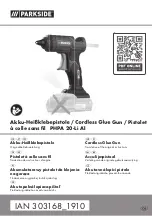
OPERATION
■
Creating a moisture barrier around areas that could
be damaged by water.
■
Sealing cracks to keep insects from crawling inside
your home.
■
Applying adhesive.
TO INSTALL BATTERY PACK (NOT INCLUDED)
(Fig. 2)
■
Lock the switch trigger by sliding the switch lock up.
■
Place the battery pack on the tool.
■
Make sure the latches on each side of the battery
pack snap into place and the battery pack is secured
on the tool before beginning operation.
CAUTION
When placing battery pack in the tool, be sure
raised rib on battery pack aligns with the bottom
of the drill and latches into place properly.
Improper installation of the battery pack can
cause damage to internal components.
TO REMOVE BATTERY PACK (NOT INCLUDED)
(Fig. 2)
■
Lock the switch trigger by sliding the switch lock up.
■
Depress the latches on the side of battery pack.
■
Remove the battery pack from the tool.
STARTING/STOPPING THE CAULK GUN (Fig. 3)
Before attempting to start the caulk gun, be sure the
switch lock is in the unlocked position.
■
To turn the caulk gun ON, depress the switch trigger.
■
To turn the caulk gun OFF, release the switch trigger.
LOCKING THE SWITCH TRIGGER (Fig. 3.)
The switch trigger of the caulk gun can be locked off
using the slide switch located below the switch trigger.
■
To lock the switch trigger, slide the switch lock up.
This will prevent the caulk gun switch trigger from
being depressed.
■
To unlock the switch trigger, slide the switch down. This
will allow the caulk gun switch trigger to be depressed.
LOADING CAULK (NOT INCLUDED) (Fig. 4 - 5)
■
Lock the switch trigger by sliding the switch lock up.
■
Using a utility knife, cut off the tip of the spout on a
standard 10 oz. tube of caulk. Cut the tip at a 45° angle.
■
Remove as little as possible, taking into consideration
the size of the "bead" of caulk you need.
■
Check for a second inner seal at the base of the spout.
If found, insert the puncture tool inside the spout
to break the seal before using. If using a partially
filled tube, use the puncture tool to remove any
hardened material from the tip.
Note:
An inner seal is usually found only in cardboard
caulk tubes.
■
While holding the caulk gun steady with one hand,
pull the handle of the plunger rod away from the
caulk gun. Continue pulling until plunger base
reaches the back of the carriage frame.
■
Load the caulk tube into the carriage frame, making
sure it is well seated at both ends.
ELECTRONIC OVERLOAD PROTECTION
The caulk gun is protected by an electronic overload
protection feature. If too much pressure is exerted on
the tube, the motor will shut down. This helps to prevent
damage to the tool and the caulk tube. If the motor
shuts off, make sure that:
■
Nozzle tip is cut
■
Inner seal in the caulk tube is broken
■
Hardened material is removed from the nozzle
■
Caulk tube is not damaged or frozen
■
Plunger rod is free of caulk/adhesive materials
Release the trigger and wait for 3 to 5 seconds to allow
the electronics to reset. If the motor again shuts off,
move the variable speed selector to the middle position
and press the trigger again. If the motor continues to shut
off, try another tube of material or take the tool to an
authorized service center.
WARNING
Battery tools are always in operating condition.
Therefore, switch should always be locked when
not in use or carrying at your side.
APPLYING CAULK (Fig. 6 - 8)
■
Prepare the surface to be caulked by removing any
dust, dirt, or remnants of old caulking. Make sure the
area to be caulked is clean and dry.
■
Set the speed of the caulk gun to match your
application needs, using just enough caulk to do the
job. Experiment in an out-of-the-way area to find the
best speed to use to deliver the caulk bead you want.
8
GB
English
F
D
E
I
P
NL
S
DK
N
FIN
GR
H
CZ
RUS
PL
RO
SLO
TR
HR
CCG-1801M manual.qxd 3/02/06 12:07 Page 8













































